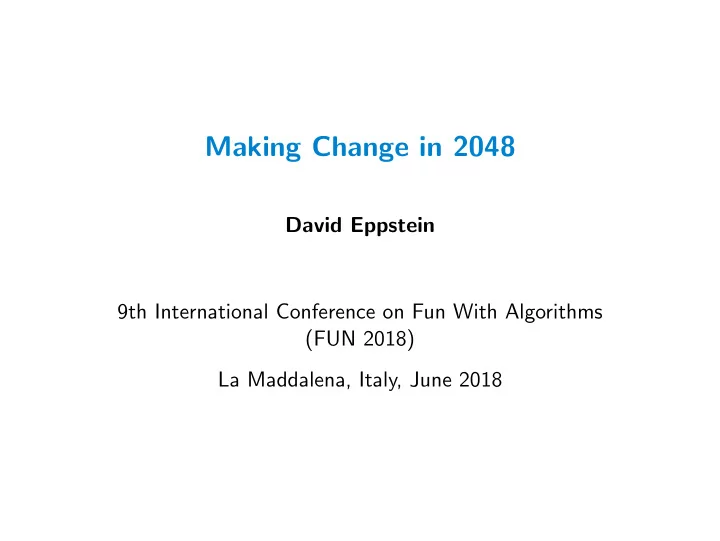

Making Change in 2048 David Eppstein 9th International Conference on Fun With Algorithms (FUN 2018) La Maddalena, Italy, June 2018
2048 game 16 squares that can be filled by power-of-two tiles Each turn: slide all squares in one of four directions When two equal tiles slide into each other they merge On each turn, one new small tile appears Goal: Keep playing long enough to see big tiles
Finiteness of the 2048 game Best possible state at any step: ◮ No two tiles are equal ◮ They form the binary representation of the current total Can’t reach numbers with more than 16 ones in their binary representation
Related game: Threes The original (predecessor of 2048) Tile values are 1, 2, and 3 · 2 i Pairs of tiles can merge when their sum is in this set (except 1 + 1 = 2) Tiles only slide one step per turn
Related game: 987 Tile values are all the Fibonacci numbers Consecutive Fibonacci numbers can merge (all pairs whose sum is a Fibonacci number) Same game play as 2048
987 analysis Zeckendorf representation: Every number is uniquely representable as sum of non-consecutive Fibonaccis E.g. = 100 = 3 + 8 + 89 When this exceeds 16 terms, at 1 + 3 + 8 + · · · = 9227464 you’re stuck Zeckendorf representations.svg from Wikimedia commons, released under Free Art License by Parcly Taxel
Do we have to separately analyze each variant? It’s not easy to understand optimal representations as sums. . . CC-BY-SA image Knapsack.svg by Dake from Wikimedia commons . . . and what about when all representations have length O (1)?
Moser–de Bruijn sequence. . . The sequence 0 , 1 , 2 , 4 , 5 , 16 , . . . of numbers whose binary representations have zeros in all odd positions Every number has a unique representation as x + 2 y for x , y in the sequence
...merged with its double If we made coins either with values in the Moser–de Bruijn sequence or two times a value in the sequence, 1, 2, 4, 5, 8, 10, 16, 17, 20, . . . Composite of images from Category:Coins by face value on Wikimedia commons . . . then cashiers could always make change using only two coins!
Does this game terminate? What if we replace the powers of two in 2048 by this sequence? Every total tile value can be represented by only two tiles! Does that mean we can keep playing forever?
Optimal vs greedy change-making For usual coins, a greedy algorithm makes change optimally (same for binary numbers and Fibonacci numbers) But this is not true in general and optimal change-making is a standard undergraduate dynamic programming exercise CC-BY-SA image Brustwechsler.jpg by Monster4711 from Wikimedia commons
These two problems are really the same! Our main result: For 2048-like games with n squares, where new tile value = 1 and you can merge any subset of tiles whose total value is another tile: Max score = min # for which greedy change-making uses n coins
So when do these games terminate? If tiles have arbitrarily large gaps, max score is finite (and can be calculated quickly from stream of tile values) In particular this is true for Moser–de Bruijn and its double Micro chess by Erhan Cubukcuoglu from http://kirill-kryukov.com/ chess/discussion-board/ viewtopic.php?f=6&t=344 Application: choosing the right size for the game board Max score for n = 16 is 954437167 Better to use n = 9 and max score 58249.
But some 2048 variants remain unanalyzed
Recommend
More recommend